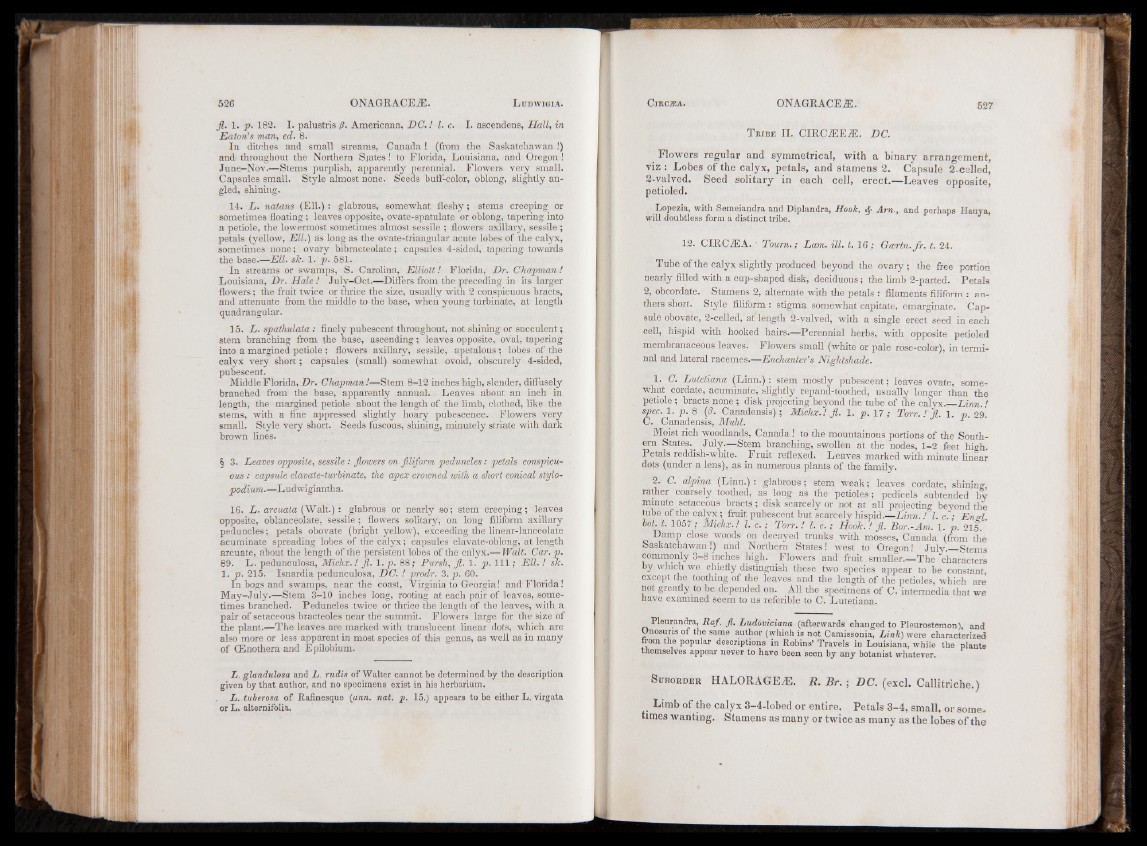
fl. 1. p. 182. I. palustris 0. Americana, D C .! 1. c. I. ascendens, Hall, in
Eaton's man, ed. 8.
In ditches and small streams, Canada i (from the Saskatchawan !)
and throughout the Northern States! to Florida, Louisiana, and Oregon!
June—Nov.—Stems purplish, apparently perennial. Flowers very small.
Capsules small. Style almost none. Seeds buff-color, oblong, slightly angled,
shining.
14. L. natans (Ell.) : glabrous, somewhat fleshy; stems creeping or
sometimes floating ; leaves opposite, ovate-spatulate or oblong, tapering into
a petiole, the lowermost sometimes almost sessile ; flowers axillary, sessile ;
petals (yellow, Ell.) as long as the ovate-triangular acute lobes of the calyx,
sometimes none; ovary bibracteolate; capsules 4-sided, tapering towards
the base.—Ell. sic. 1. p. 581.
In streams or swamps, S. Carolina, Elliott! Florida, Dr. Chapman!
Louisiana, Dr. Hale ! July-Oct.—Differs from the preceding in its larger
flowers; the fruit twice or thrice the size, usually with 2 conspicuous bracts,
and attenuate from the middle to the base, when young turbinate, at length
quadrangular.
15. L. spathulata : finely pubescent throughout, not shining or succulent;
stem branching from the base, ascending; leaves opposite, oval, tapering
into a margined petiole ; flowers axillary, sessile, apetalous ; lobes of the
calyx very short; capsules (small) somewhat ovoid, obscurely 4-sided,
pubescent.
Middle Florida, Dr. Chapman!—Stem 8-12 inches high, slender, diffusely
branched from the base, apparently annual. Leaves about an inch in
length, the margined petiole about the length of the limb, clothed, like the
stems, with a fine appressed slightly hoary pubescence. Flowers very
small. Style very short. Seeds fuscous, shining, minutely striate with dark
brown lines.
§ 3. Leaves opposite, sessile : flowers on filiform peduncles: petals conspicuous
: capsule clavate-turlinate, the apex crowned with a short conical stylopodium.—
L udwigiantha.
16. L. arcuala (Walt.) : glabrous or nearly so; stem creeping; leaves
opposite, oblanceolate, sessile; flowers solitary, on long filiform axillary
peduncles; petals obovate (bright yellow), exceeding the linear-lanceolate
acuminate spreading lobes of the calyx; capsules elavate-oblong, at length
arcuate, about the length of the persistent lobes of the calyx.— Walt. Car. p.
89. L. pedunculosa, Michx.! fl. 1. p. 88; Pursh, fl. 1. p. I l l ; Ell. ! sk.
1. p. 215. Isnardia pedunculosa, DC. ! prodr. 3. p. 60.
In bogs and swamps, near the coast, Virginia to Georgia! and Florida!
May-July.—Stem 3-10 inches long, rooting at each pair of leaves, sometimes
branched. Peduncles twice or thrice the length of the leaves, with a
pair of setaceous bracteoles near the summit. Flowers large for the size of
the plant.—The leaves are marked with translucent linear dots, which are
also more or less apparent in most species of this genus, as well as in many
of CEnothera and Epilobium.
L. glandulosa and L. rudis of Walter cannot be determined by the description
given by that author, and no specimens exist in his herbarium.
L. tuberosa of Rafinesque (ann. nat. p. 15.) appears to be either L. virgata
or L. alternifolia.
T ribe II. CIRC-EEjE. DC.
Flowers regular and symmetrical, with a binary arrangement,
viz : Lobes of the calyx, petals, and stamens 2. Capsule 2-celled,
2-valved. Seed solitary in each cell, erect.—Leaves opposite,
petioled,
Lopezia, with Semeiandra and Diplandra, Hook. Am., and perhaps Hauya,
will doubtless form a distinct tribe.
12. CIRCiEA. Tourn.; Lam. ill. t. 16 ; Gcertn.fr. t. 24.
Tube of the calyx slightly produced beyond the ovary ; the free portion
nearly filled with a cup-shaped disk, deciduous; the limb 2-parted. Petals
2, obcordate. Stamens 2, alternate with the petals : filaments filiform : anthers
short. Style filiform : stigma somewhat capitate, emarginate. Capsule
obovate, 2-celled, at length 2-valved, with a single erect seed in each
cell, hispid with hooked hairs.—Perennial herbs, with opposite petioled
membranaceous leaves. Flowers small (white or pale rose-color), in terminal
and lateral racemes.—Enchanter's Nightshade.
1. C. Lutetiana (Linn.): stem mostly pubescent; leaves ovate, somewhat
cordate, acuminate, slightly repand-toothed, usually longer than the
petiole ; bracts none ; disk projecting beyond the tube of the calyx.__Linn.!
spec. 1. p. 8 (0. Canadensis); Michx.! fl. 1. p. 17 ; Torr. ! fl. 1. r> 29
C. Canadensis, Muhl.
Moist rich woodlands, Canada! to the mountainous portions of the Southern
States. _ July.—Stem branching, swollen at the nodes, 1-2 feet high.
Petals reddish-white. Fruit reflexed. Leaves marked with minute linear
dots (under a lens), as in numerous plants of the family.
2. C. alpina (Linn.): glabrous; stem weak; leaves cordate, shining,
rather coarsely toothed, as long as the petioles; pedicels subtended by
minute setaceous bracts; disk scarcely or not at all projecting beyond the
tube of the calyx; fruit pubescent but scarcely hispid.—Linn.! 1. c.; Enel,
lot. t. 1057 ; Michx.! 1. c .; Torr. ! 1. c .; Hook. ! fl. Bor.-Am. 1. p. 215. *
Damp close woods on decayed trunks with mosses, Canada (from the
Saskatchawan!) and Northern States! west to Oregon! July.__Stems
commonly 3-8 inches high. Flowers and fruit smaller__The characters
by which we chiefly distinguish these two species appear to be constant,
except the toothing of the leaves and the length of the petioles, which are’
not greatly to be depended on. All the specimens of C. intermedia that we
have examined seem to us referible to C. Lutetiana.
Pleurandra, Raf. fl. Ludoviciana (afterwards changed to Pleurostemon), and
Onosuris of the same author (which is not Camissonia, Link) were characterized
iiom the popular descriptions in Robins* Travels in Louisiana, while the plants
themselves appear never to have been seen by any botanist whatever.
S uborder HALORAGE^E. R. Br. ; DC. (excl. Callitriche.)
Limb of the calyx 3-4-lobed or entire. Petals 3-4, small, or sometimes
wanting. Stamens as many or twice as many as the lobes of the